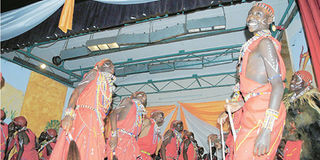New book a celebration of Maasai heroes and heroines

Title: The Maasai Pioneers
Author: Sironka Ole Masharen
Publisher: Self
Year of Publication: 2009
Pages: 194
Reviewed by JULIUS SIGEI
When renowned Kenyan writer H.R Ole Kulet penned his debut novel Is It Possible? in 1971, the question then was: Is it possible to hold a spear in one hand and a book in the other? In other words, can the traditional Maasai lifestyle go hand in hand with Western education?
The answer, clearly, is yes, since the Maasai have assimilated what is good in the Western culture while at the same time retaining aspects of their traditional culture that has made them the subject of envy the world over.
But writing this year, nearly four decades later, Sironka Ole Masharen asks in his book The Maasai Pioneers, whether it is possible to be a Maasai without cattle.
Long-held traditions
He says many socio-economic problems confounding the Maasai today in his environment make the revision of some long-held traditions inevitable. Thus he argues for the need to diversify modes of production from nomadic pastoralism to agriculture, bee keeping and fishing.
The writer also argues passionately for environmental conservation. But Ole Masharen goes beyond the usual hue and cry over the destruction of water catchments to include other equally harmful practices like overstocking, pollution and unsustainable diversion of rivers for agriculture to the detriment of those living downstream.
Likening the Maasai to the Maoris of New Zealand and the Aborigines of Australia, Ole Masharen argues that the Maasai language and culture is endangered and calls for its preservation. He writes: “the degradation of the environment also goes hand in hand with cultural erosion. The Maa language should be revived, popularised and even internationalised.”
In a chapter titled ‘‘The Maasai Women’’, Ole Masharen writes: “among the Maasai, a woman is called enkitok, meaning the great one. This is paradoxical, for women among the Maasai are not accorded the respect commensurate with their title. They are entirely dependent on men to whom they live on their utter subjection.”
For instance, he says the first Maasai woman to attend school in 1942, Loise Mpayiai, was not formally included in the school attendance register. He says, “when the news of her admission reached the prophets in Tanganyika, they convened a meeting to ascertain the truth of the earth-shaking matter. Among those summoned was Chief Kulale who denied his involvement in the matter and promised to rescind the decision as soon as he came back home.”
A lamentation
But The Maasai Pioneers is also a lamentation of the real and imagined problems the Maasai have undergone since the Anglo-Maasai agreements of 1904 and 1911 in which the latter lost more than half of their original land. Masharen apologises for the legendary Chief Olonana whom he says signed the first agreement under duress. He accuses subsequent governments of glossing over this issue that has come to be called ‘‘The Maasai Question.’’
Masharen also claims that the Maasai are victims of conservation laws. He says that while four major national parks – Tsavo, Amboseli, Nairobi and the world famous Maasai Mara – are found in Maasailand “the local people benefit very little or not at all from tourism which is supposed to act as their cash crop, petroleum or any other valuable mineral known on earth.
“The result of this is conflict over water points, grazing land, injuries and deaths from attacks by wildlife, making wildlife conservation a liability for the local communities,” he says.
A key strength of this book is the pictorial presentation which gives the history of Maasai pioneers at a glance. Here you will find such people as Heritage minister William ole Ntimama, controversial politician John Keen, the late Vice-President Joseph Ole Murumbi and a host of other leaders in education, business and politics. It also contains characteristic Maasai dances and ceremonies.
While the book is clearly a celebration of the community’s heroes and heroines, one glaring omission is the place of scribes in the whole picture. So such preeminent writers like Naomi Kipury and Leteipa Ole Sunkuli in the field of oral literature, and H.R Ole Kulet who has authored eight acclaimed novels, are not mentioned.
Also while the book is an academic text with citations and all, typographical errors and sometimes outright grammatical mistakes are not uncommon – a common feature in self-published books. All in all, the author has put in great effort in terms of research and readers will benefit immensely from this information-rich book.
A graduate of Kenyatta University, the author is a researcher and a politician. He says he set out to correct stereotypes like that the Maasai are bloodthirsty and ferocious. As Professor Sarone Ole Sena has written in the foreword, Masharen has succeeded in weaving out Maasai history, culture, leadership, politics, land, and other pertinent issues throughout the book, making it informative and interesting to read. It is has something for the literary scholar, the historian, the anthropologist and the general reader.
The writer is a journalist and a literary commentator. [email protected]




